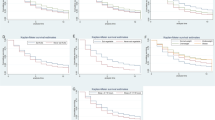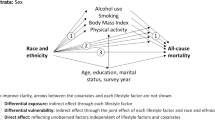Abstract
Background
Lifestyle risk factors have been associated with increased all-cause and cause-specific mortality, but the influence of reverse causation has been underappreciated as a limitation in epidemiological studies.
Methods
Prospective cohort study including 457,021 US adults from the National Health Interview Survey 1997–2013 linked to the National Death Index records through December 31, 2015. Multivariable Cox models were performed to examine the association of lifestyle risk factors with all-cause and cause-specific mortality. Participants with prevalent diseases and the first 2, 5, 10, and 15 years of follow-up were excluded to account for reverse causation.
Results
During 4,441,609 person-years, we identified 60,323 total deaths. Heavy alcohol drinking (HR 1.12; 95% CI 1.08 to 1.16), smoking (HR 1.78; 95% CI 1.74 to 1.83) and lack of physical activity (HR 1.51; 95% CI 1.47 to 1.54) were associated with increased all-cause mortality. Overweight was associated with lower all-cause mortality (HR 0.88; 95% CI 0.86 to 0.90). After exclusion of participants with diseases and first 10 years of follow-up, associations changed to: heavy alcohol drinking (HR 1.31; 95% CI 1.20 to 1.43), smoking (HR 1.99; 95% CI 1.87 to 2.11), lack of physical activity (HR 1.21; 95% CI 1.15 to 1.27), and overweight (HR 1.05; 95% CI 1.00 to 1.10).
Conclusions
Methods to account for reverse causation suggest different effects of reverse causation on the associations between lifestyle risk factors and mortality. Exclusion of participants with diseases at baseline, and exclusion of 5–10 years of follow-up may be necessary to mitigate reverse causation.



Similar content being viewed by others
Availability of data and materials
The National Health Interview Survey data are available at www.cdc.gov/nchs/nhis/index.htm.
References
Zhang YB, Pan XF, Chen J, et al. Combined lifestyle factors, all-cause mortality and cardiovascular disease: a systematic review and meta-analysis of prospective cohort studies. J Epidemiol Community Health. 2021;75:92–9.
Zhang YB, Pan XF, Chen J, et al. Combined lifestyle factors, incident cancer, and cancer mortality: a systematic review and meta-analysis of prospective cohort studies. Br J Cancer. 2020;122:1085–93.
Rezende LFM, Lee DH, Giovannucci E. Possible reverse causation and confounding in study of the association of sedentary behavior with cancer mortality. JAMA Oncol. 2020;7:138–9.
Rezende LFM, Lee DH, Ferrari G, et al. Confounding due to pre-existing diseases in epidemiologic studies on sedentary behavior and all-cause mortality: a meta-epidemiologic study. Ann Epidemiol. 2020;52:7–14.
Lee DH, Keum N, Hu FB, et al. Predicted lean body mass, fat mass, and all cause and cause specific mortality in men: prospective US cohort study. BMJ. 2018;362:k2575.
Strain T, Wijndaele K, Sharp SJ, et al. Impact of follow-up time and analytical approaches to account for reverse causality on the association between physical activity and health outcomes in UK Biobank. Int J Epidemiol. 2020;49:162–72.
Lee DH, Giovannucci EL. Body composition and mortality in the general population: A review of epidemiologic studies. Exp Biol Med (Maywood). 2018;243:1275–85.
Aune D, Sen A, Prasad M, et al. BMI and all cause mortality: systematic review and non-linear dose-response meta-analysis of 230 cohort studies with 3.74 million deaths among 30.3 million participants. BMJ. 2016;353:i2156.
Botman SL, Moore TF, Moriarity CL, Parsons VL. Design and estimation for the National Health Interview Survey, 1995–2004. Vital and health statistics. Series 2, Data evaluation and methods research, No. 130. Hyattsville: National Center for Health Statistics; 2000. p. 1–31.
National Center for Health Statistics, M. G. Kovarand G. S, Poe. The National Health Interview Survey Design, 1973-84, and Procedures, 1975-83. Vital and Health Statistics. Series 1, No.18. DHHS Pub. No. (PHS) 85-1320. Public Health Service. https://www.cdc.gov/nchs/data/series/sr_01/sr01_018acc.pdf
National Center for Health Statistics. The Linkage of National Center for Health Statistics Survey Data to the National Death Index—2015 Linked Mortality File (LMF): methodology overview and analytic considerations. Centers for Disease Control and Prevention; 2019. Accessed 7 Jan 2020. https://www.cdc.gov/nchs/data/datalinkage/LMF2015_Methodology_Analytic_Considerations.pdf
National Center for Health Statistics. Linkage methods and analytical support for NCHS linked mortality data. Accessed 16 Oct 2020. https://www.cdc.gov/nchs/data-linkage/mortalitymethods.htm
Xu J, Murphy SL, Kochanek KD, et al. Deaths: final data for 2013. Natl Vital Stat Rep. 2016;64:1–119.
Wannamethee SG, Shaper AG, Lennon L. Reasons for intentional weight loss, unintentional weight loss, and mortality in older men. Arch Intern Med. 2005;165:1035–40.
The Global BMI Mortality Collaboration, Di Angelantonio E, Bhupathiraju SN, et al. Body-mass index and all-cause mortality: individual-participant-data meta-analysis of 239 prospective studies in four continents. Lancet. 2016;388:776–86.
Lee DH, Rezende LFM, Ferrari G, et al. Physical activity and all-cause and cause-specific mortality: assessing the impact of reverse causation and measurement error in two large prospective cohorts. Eur J Epidemiol. 2020;36:275–85.
de Gonzalez AB, Hartge P, Cerhan JR, et al. Body-mass index and mortality among 1.46 million white adults. N Engl J Med. 2010;363:2211–9.
Collaboration NCDRF. Worldwide trends in body-mass index, underweight, overweight, and obesity from 1975 to 2016: a pooled analysis of 2416 population-based measurement studies in 128.9 million children, adolescents, and adults. Lancet. 1975;2017(390):2627–42.
Ortola R, Garcia-Esquinas E, Lopez-Garcia E, et al. Alcohol consumption and all-cause mortality in older adults in Spain: an analysis accounting for the main methodological issues. Addiction. 2019;114:59–68.
Vie GA, Wootton RE, Bjorngaard JH, et al. The effect of smoking intensity on all-cause and cause-specific mortality—a Mendelian randomization analysis. Int J Epidemiol. 2019;48:1438–46.
Mucha L, Stephenson J, Morandi N, et al. Meta-analysis of disease risk associated with smoking, by gender and intensity of smoking. Gend Med. 2006;3:279–91.
Taghizadeh N, Vonk JM, Boezen HM. Lifetime smoking history and cause-specific mortality in a cohort study with 43 years of follow-up. PLoS ONE. 2016;11:e0153310.
Tarp J, Hansen BH, Fagerland MW, et al. Accelerometer-measured physical activity and sedentary time in a cohort of US adults followed for up to 13 years: the influence of removing early follow-up on associations with mortality. Int J Behav Nutr Phys Act. 2020;17:39.
Behrens G, Matthews CE, Moore SC, et al. Body size and physical activity in relation to incidence of chronic obstructive pulmonary disease. CMAJ. 2014;186:E457–69.
Bhaskaran K, Douglas I, Forbes H, et al. Body-mass index and risk of 22 specific cancers: a population-based cohort study of 5.24 million UK adults. Lancet. 2014;384:755–65.
Sun YQ, Burgess S, Staley JR, et al. Body mass index and all cause mortality in HUNT and UK Biobank studies: linear and non-linear Mendelian randomisation analyses. BMJ. 2019;364:l1042.
Funding
None declared.
Author information
Authors and Affiliations
Contributions
L.F.M.R., D.H.L, G.F., J.N., and Y.W. designed and conceptualized study. L.F.M.R., B.L., W.H., J.N., and Y.W. had a major role in the acquisition, analysis, or interpretation of the data. L.F.M.R., wrote the first draft of the manuscript. All authors contributed to the interpretation of data and commented on previous versions of the manuscript. All authors read and approved the final manuscript.
Corresponding author
Ethics declarations
Conflict of interest
The authors declare that they have no conflict of interest.
Ethical approval
The National Health Interview Survey data in this study are deidentified and do not include any protected health information. This study was based on secondary analyses of publicly available and deidentified NHIS data and no further institutional review board approval is needed for this study.
Additional information
Publisher's Note
Springer Nature remains neutral with regard to jurisdictional claims in published maps and institutional affiliations.
Supplementary Information
Below is the link to the electronic supplementary material.
Rights and permissions
About this article
Cite this article
Rezende, L.F.M., Ferrari, G., Lee, D.H. et al. Lifestyle risk factors and all-cause and cause-specific mortality: assessing the influence of reverse causation in a prospective cohort of 457,021 US adults. Eur J Epidemiol 37, 11–23 (2022). https://doi.org/10.1007/s10654-021-00829-2
Received:
Accepted:
Published:
Issue Date:
DOI: https://doi.org/10.1007/s10654-021-00829-2




